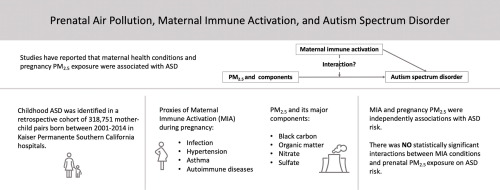
# Air Pollution and Autism: Uncovering Possible Risk Factors for Brain Development
_A pioneering scientific review highlights how exposure to prevalent air pollutants during crucial stages of brain development may elevate the risk of Autism Spectrum Disorder (ASD). The study focuses on particular pollutants and pathways, underscoring an urgent necessity for more in-depth investigation of this environmental risk factor._
—
**Published in:** Brain Medicine, November 12, 2024 | **Reading time:** 6 minutes
—
## Introduction
With the worldwide prevalence of Autism Spectrum Disorder (ASD) estimated at **1-1.5%** of the population, researchers are increasingly looking to environmental factors that might help explain this rise. Among these concerns, air pollution stands out. A recent review published in *Brain Medicine* presents essential research investigating how exposure to air pollution, especially **during pregnancy and early childhood**, could heighten the risk of ASD by impacting brain development through various biological mechanisms.
## Understanding Autism and Environmental Risks
Autism Spectrum Disorder is a multifaceted neurodevelopmental condition marked by difficulties in social interaction, communication, and repetitive behaviors. While genetic elements have been historically linked to the disorder, recent studies are uncovering how environmental factors—air pollution included—play a vital role in the risk of developing ASD. This finding is increasingly disconcerting as urbanization continues to escalate pollution levels globally.
The **in-depth scientific review** points out how specific pollutants, like **fine particulate matter (PM2.5)** and **nitrogen oxides (NOx)**, may contribute to the onset of ASD by disrupting key neurodevelopmental processes occurring **in utero** and **during early childhood**.
## Critical Timing of Exposure to Air Pollution
A significant insight from the study is the **timing of exposure** to these pollutants. Professor Haitham Amal, the lead author and researcher at the Hebrew University of Jerusalem, noted that the susceptibility to the detrimental effects of air pollution markedly increases during particular developmental phases, particularly the **prenatal period** and early childhood.
These stages are characterized by rapid brain growth and differentiation:
– **Prenatal exposure**: Throughout pregnancy, the developing fetus’ brain experiences vital growth. Pollutants like PM2.5 can penetrate the **placental barrier**, resulting in harmful particles interacting directly with the fetal brain and potentially disrupting normal development.
– **Early childhood exposure**: These formative years are crucial for establishing essential neural connections that are foundational for cognitive and social abilities. Any disruption in these processes can result in long-lasting effects on brain function.
“The delicate nature of brain development during these initial stages renders pollution exposure at such times extremely concerning,” Professor Amal emphasized.
## How Pollutants Affect Brain Development: Multiple Pathways
The study delineates several **biological pathways** through which air pollutants influence the brain, potentially heightening the risk of ASD:
1. **Inflammation**: Exposure to particulate matter and various pollutants can induce **neuroinflammation**, a condition where the brain’s immune response becomes excessive. Prolonged inflammation harms brain cells and disrupts normal neurodevelopment.
2. **Oxidative Stress**: Associated with air pollutants like nitrogen oxides (NO), oxidative stress denotes the cellular harm caused by detrimental free radicals. This imbalance can disturb normal brain function and development, particularly regarding sensitive developing neural tissues.
3. **Disruptions to Neurotransmitter Systems**: Pollutants have been shown to impact the production and function of neurotransmitters—chemical messengers in the brain vital for communication among nerve cells. This disruption has been correlated with neural dysfunction connected to conditions like ASD.
4. **Changes in Gene Expression**: Certain pollutants may influence **epigenetic modifications**, which can alter gene expression. This is particularly alarming for individuals who may have a genetic predisposition to ASD, as environmental triggers like pollutants can further intensify genetic vulnerabilities.
Professor Amal further emphasizes the significance of these findings, stating, “The interaction of **nitric oxide (NO)** and its derivatives with crucial brain functions underscores the complexity of this environmental risk for ASD. NO plays an essential role in regulating neurotransmitters, and our study further fortifies how pollutants can disrupt this, leading to developmental repercussions.”
## Interaction Between Genetics and Environment
A remarkable aspect of the research is the concept of **gene-environment interaction**. While genetic factors are recognized as playing a major role in the origins of autism, this study indicates that individuals with existing **genetic predispositions to ASD** may be particularly susceptible to the adverse effects of air pollution. The combined impact of genetic tendencies and environmental exposure could account for the varying autism risk levels observed across different populations.
Professor Amal and his team propose that ongoing research into how air pollution interacts with genetic profiles might pave the way for **personalized ASD prevention** strategies—identifying individuals at greater risk based on their environmental exposure and genetic make-up.
## Policy